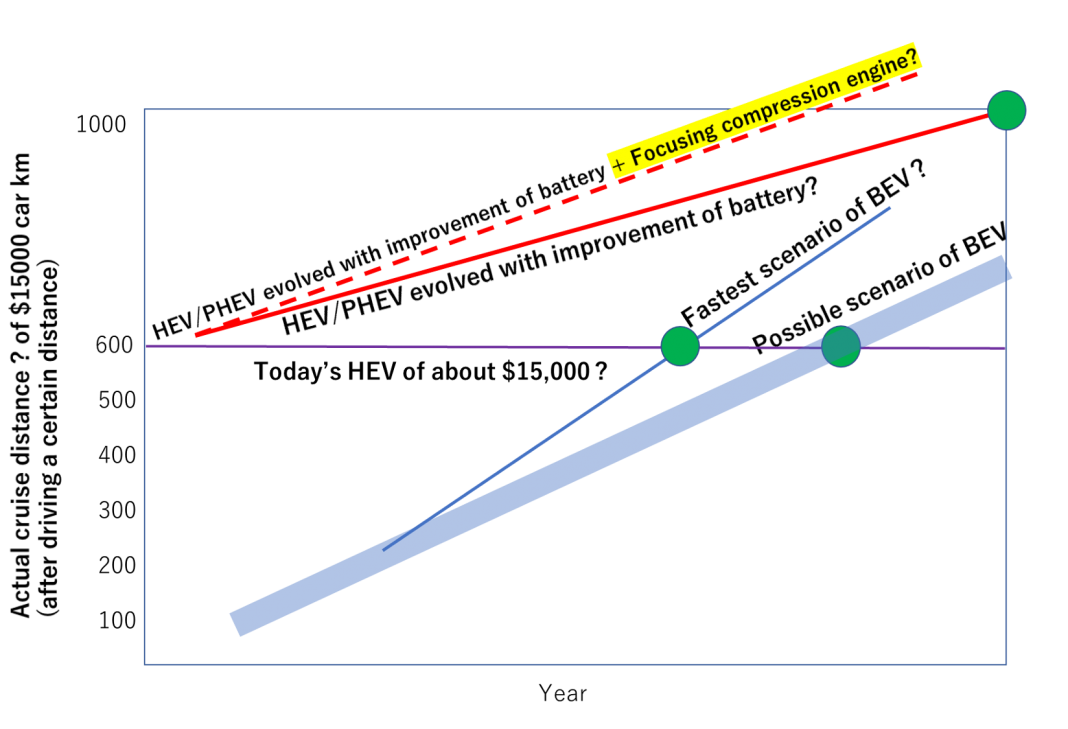Professor Ken Naitoh from Waseda University in Japan charts a particular interdisciplinary carbon-neutral approach for reducing climate change and global warming that he believes will lead to a more peaceful world
My previous report introduces a scientific approach based on the hyper-gourd theory for producing quantum leaps of subatomic, biological, cerebral, economic, cosmic, and information worlds to many readers. Based on the approach, we propose a concrete scenario of a short-middle-long range toward a carbon-neutral or carbon-zero world, which may solve problems of climate change and global warming, while also leading to a more peaceful world.
Reducing climate change: The outlook for combustion engines and batteries
First, let’s examine the status quo concerning battery electric vehicles without combustion engines (BEVs) and hybrid engine vehicles, including smaller batteries (HEVs). It is well-known that the production of BEVs produces CO2, which may be comparable to that produced by combustion engines of automobiles while driving over a few years.
BEVs emit much CO2 only during about half a year of BEV production because CO2 is emitted from today’s power generator stations based on the combustion of fuels, including carbon. Even countries using much atomic energy still employ combustion to a certain extent. Thus, should BEVs be increased in the market after reducing CO2 generator stations? If restrictions on combustion engines are too strong, many users may buy second-used cars, i.e., HEVs repaired.
Of course, now is the time for companies to develop BEV technologies, because if a battery with more than five times the performance shows up, then combustion engines will no longer be needed. However, the way forward will not be robust this century without combustion engines. In the next section, let us see the other reason.
Let’s examine the qualitative figure of cruising distance for automobiles around $15,000, plotted against the year. The first key point is when the possible cruising distance of BEVs (blue line) will be over 600 km per one energy charge. If today’s performance of HEVs is at a horizontal line (purple line), the cruising distance line of BEVs (blue line) may cross that of HEVs before 2050. Some people in the world may think of this crossing point.
However, secondly, as a HEV also has a battery, the cruising distance of the HEV is not on a horizontal line. A HEV using traditional combustion engines with poppet valves will also be improved according to the lower red line. Emphasis is placed on the outlook that if the new engine based on the focusing compression principle proposed by the author (Fugine: upper dot-red line) is sold in the market, BEV will not be able to win the superior HEV based on the focusing compression principle, even around the end of this century. This is because Fugine has high thermal efficiency based on a relatively silent high compression ratio without knocking and a certain air- insulation effect, i.e., less CO2. See the upper dot-red line for HEVs with the focusing compression engine.
Moreover, aircraft and rockets will use engines as primary power sources, including batteries, in the next century.

The short-middle-long range scenario for carbon-neutral or carbon-zero would
The scenario consists of five steps.
- (1st step)
- The recent reduction of individual travelling distance of automobiles per year. The new type of virus, COVID-19, also reduced the usage of automobiles. The cruising distance of my car was reduced to about 3,000 km during 2020, whereas it was about 8,000 km per year before 2019. As a result, my car’s CO2 exhaust gas emissions are about 50%, although people cannot reduce the cruising distance annually for some parts.
- On inspection, the government can check the total cruising distances, i.e., the amount of CO2 integrated. Tax may be considered with cruising distance and amount of CO2 emitted, including the amount when producing new cars. It is emphasised that the number of cars driven now is much more than new cars, which will be sold in the next year.
- (2nd step)
- CO2 reduction until about 2035: HEVs and PHEVs should be increased during the next ten or twenty years, because of the figure of cruising distance plotted against the year. This is also because people will especially want PHEVs, which make long cruising distances possible and supply electricity in emergencies, which are cheaper than BEVs.
- (3rd step)
- PHEVs with focusing compression engines (Fugine) may bring less CO2 because of higher thermal efficiency potential. Moreover, our Fugine based on the focusing compression principle also shows stable combustion data using very lean hydrogen gas at low injection pressure, which may imply a particular approach toward carbon zero.
- (4th step)
- Recycle of mass and energy: Much waste appears because people do not keep old products as waste used in their houses. Mass conservation law is “Products ≒ Wastes” because parts of mass wasted, except for food, will not be recycled. We think that parts of mass and waste energy should also be recycled using Fugine.
- (5th step)
- The quantum leap of concept, i.e., power source based on focusing compression principle (Fusine: Fusion engine), was also proposed in about 2010, which tries to employ a weak nuclear reaction without radiation. This shows a possibility of power that is more than combustion alone. This may also bring carbon zero and easy travel out of the Earth.
References
- https://www.webcartop.jp/2021/01/639410/
- Kobayashi et al. SAE paper AeroTech, 2023 https://www.sae.org/publications/technical-papers/content/2023-01-0984/
- Ken Naitoh et al. SAE paper WCX, 2023 https://www.sae.org/publications/technical-papers/content/2023-01-0401/
- Kobayashi, T, Naitoh, K, et al., (2021) Development of weak cold-fusion engine reactor (fusine) assisted by molecular chemical reaction: based on focusing– compression of 1000 bar and 7000 K due to pulsed supermulti-jets colliding, Journal of Condensed Matter Nuclear Science, 19, 148–166.
- https://www.openaccessgovernment.org/article/interdisciplinary-research-on-the-splitting-process-of-various-particles/167887/

This work is licensed under Creative Commons Attribution-NonCommercial-NoDerivatives 4.0 International.


